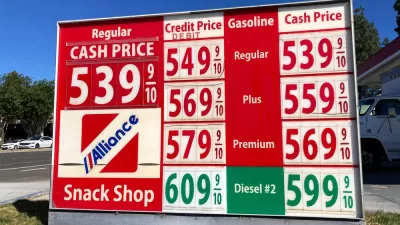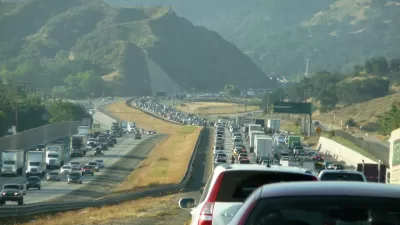Urban economist Joe Cortright examines the connection between gas prices and driving in the U.S. over the last two decades. Prices matter: increased gas prices results in decreased driving, providing the prices persist for the long-term.

"The relationship between prices and driving isn’t perfect and instantaneous," writes Cortright, director of Portland, Ore.-based City Observatory, for CityLab on Feb. 28.
People make decisions about where to live, how far they’re willing to commute to work, whether to own a car (or a second car), and whether to use various other modes (cycling, transit, and walking) on a long-term basis. But, especially over time, prices influence all of these decisions.
To prove his point, Cortright examines four distinct time periods from 2000 to 2018 based on the price level of gasoline. An interactive graph from the Federal Reserve Economic Data (FRED), maintained by the research division of the Federal Reserve Bank of St. Louis, illustrates the inverse relationship between gas prices and vehicle miles traveled (VMT) for this time period. Note that gas prices are not adjusted for inflation and that VMT is measured per capita.
Four distinct phases in the price of gasoline and the attendant patterns of American driving
- 2000 through 2004 (4 years): Era of cheap gas and rising VMT: "'[P]eak driving' in the U.S. was in June 2005, when Americans drove 27.7 miles per person per day. At the time, gasoline cost an average of about $2.13 per gallon," writes Cortright.
- Phase 2: 2005 to July 2014: (9+ years): Expensive gas era. "By 2013, the typical American was driving about 25.7 miles, more than 2 miles per person per day less than at the peak."
- Phase 3: 2014-2016 (2 years): Cheaper gas again. Gas prices began falling in July 2014. After OPEC met in Vienna on November 27 and decided that maintaining market share preempted stabilizing gas prices, prices plummeted. "In April 2014, gas prices averaged more than $3.70 a gallon, and people drove an average of 25.7 miles per day. Some 22 months later, in February 2016, with prices averaging about $1.75 a gallon, consumers were driving about 26.7 miles per day, about 4 percent more."
- Phase 4: 2016-2018 (2 years): A rebound in gas prices:
Over the past two years, gas prices have again trended upward, rising from less than $2 per gallon to nearly $3 per gallon. As they’ve done so, the growth in per-capita driving has slowed, and—once again—reversed. Vehicle miles traveled per person peaked in late 2017, and have been trending down again since then.
On March 3, the average gas price in the U.S. was $2.46 per gallon, according to AAA. The most recent data of vehicle miles traveled from the Federal Highway Administration's Traffic Volume Trends is for November 2018, showing a 0.3% increase compared with November 2017, which is also the same increase for cumulative travel for 2018. However, FHWA does not adjust for population growth.
Cortright's conclusion:
Sustained high prices for gasoline lead to real reductions in vehicle miles traveled, in pollution and in car deaths. If we price travel appropriately, consumers will make different decisions—ones that significantly reduce the social and environmental costs of car travel. Prices matter and should be at the heart of all of our efforts to cope with climate change and build stronger and safer communities.
Alternative perspective
"A brief analysis by the State Smart Transportation Initiative found a weak connection between VMT and gas prices, and a rather strong one between vehicle miles and urban density," wrote Eric Jaffe for CityLab in March 2012 (posted here).
Cortright's post is also available on City Observatory.
FULL STORY: The High Price of Cheap Gasoline

Maui's Vacation Rental Debate Turns Ugly
Verbal attacks, misinformation campaigns and fistfights plague a high-stakes debate to convert thousands of vacation rentals into long-term housing.

Planetizen Federal Action Tracker
A weekly monitor of how Trump’s orders and actions are impacting planners and planning in America.

San Francisco Suspends Traffic Calming Amidst Record Deaths
Citing “a challenging fiscal landscape,” the city will cease the program on the heels of 42 traffic deaths, including 24 pedestrians.

Defunct Pittsburgh Power Plant to Become Residential Tower
A decommissioned steam heat plant will be redeveloped into almost 100 affordable housing units.

Trump Prompts Restructuring of Transportation Research Board in “Unprecedented Overreach”
The TRB has eliminated more than half of its committees including those focused on climate, equity, and cities.

Amtrak Rolls Out New Orleans to Alabama “Mardi Gras” Train
The new service will operate morning and evening departures between Mobile and New Orleans.
Urban Design for Planners 1: Software Tools
This six-course series explores essential urban design concepts using open source software and equips planners with the tools they need to participate fully in the urban design process.
Planning for Universal Design
Learn the tools for implementing Universal Design in planning regulations.
Heyer Gruel & Associates PA
JM Goldson LLC
Custer County Colorado
City of Camden Redevelopment Agency
City of Astoria
Transportation Research & Education Center (TREC) at Portland State University
Jefferson Parish Government
Camden Redevelopment Agency
City of Claremont





























